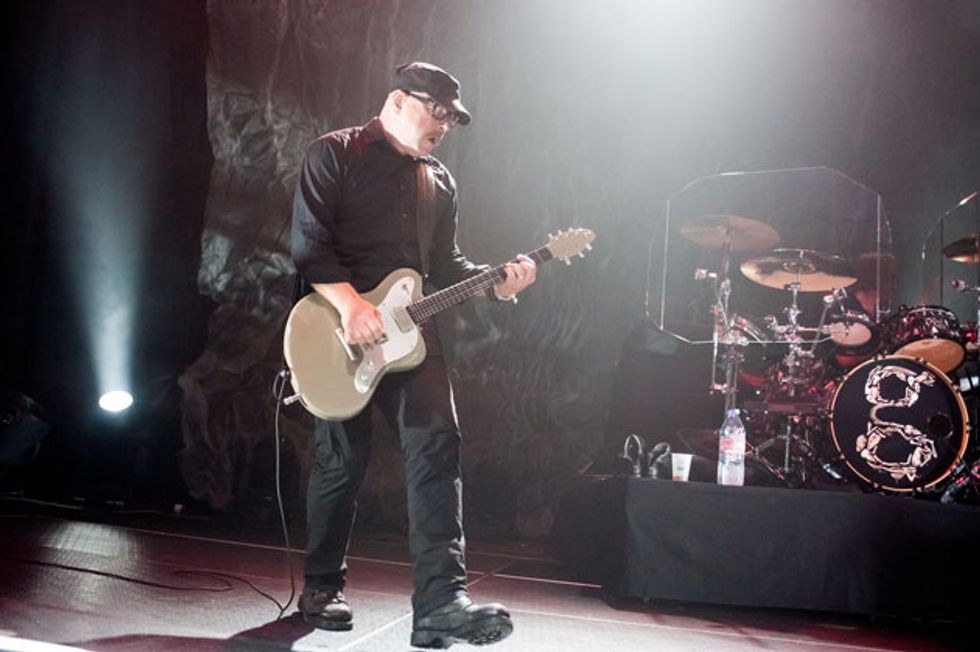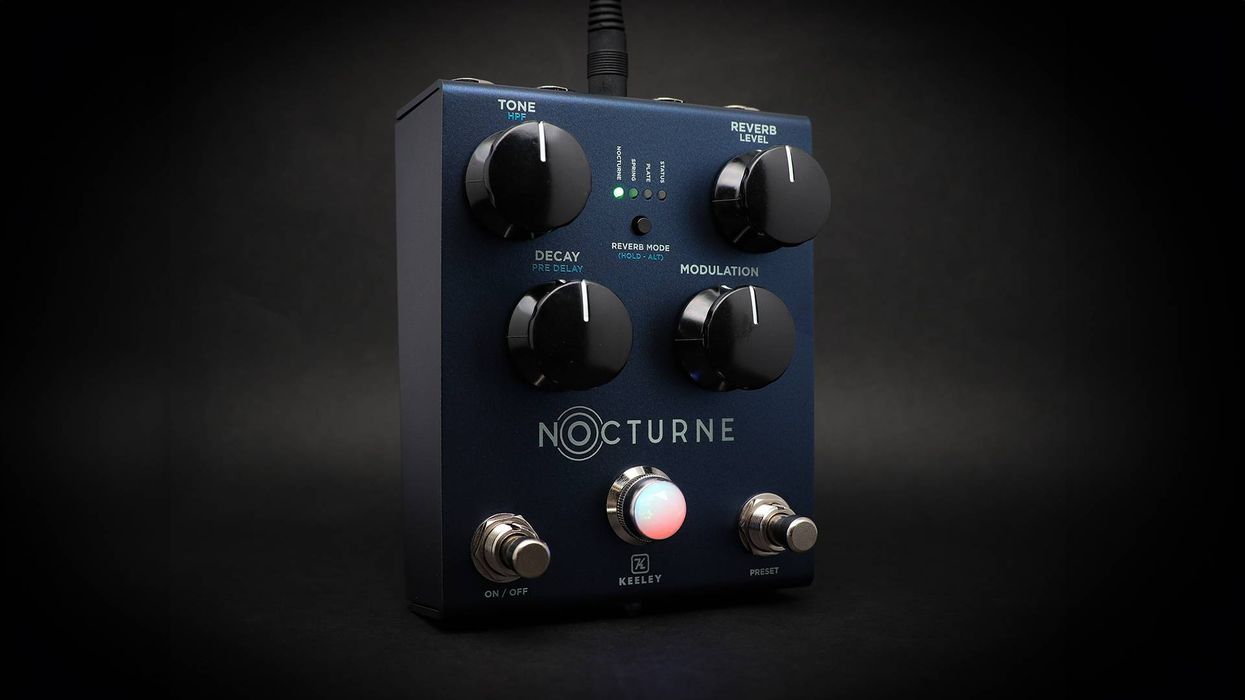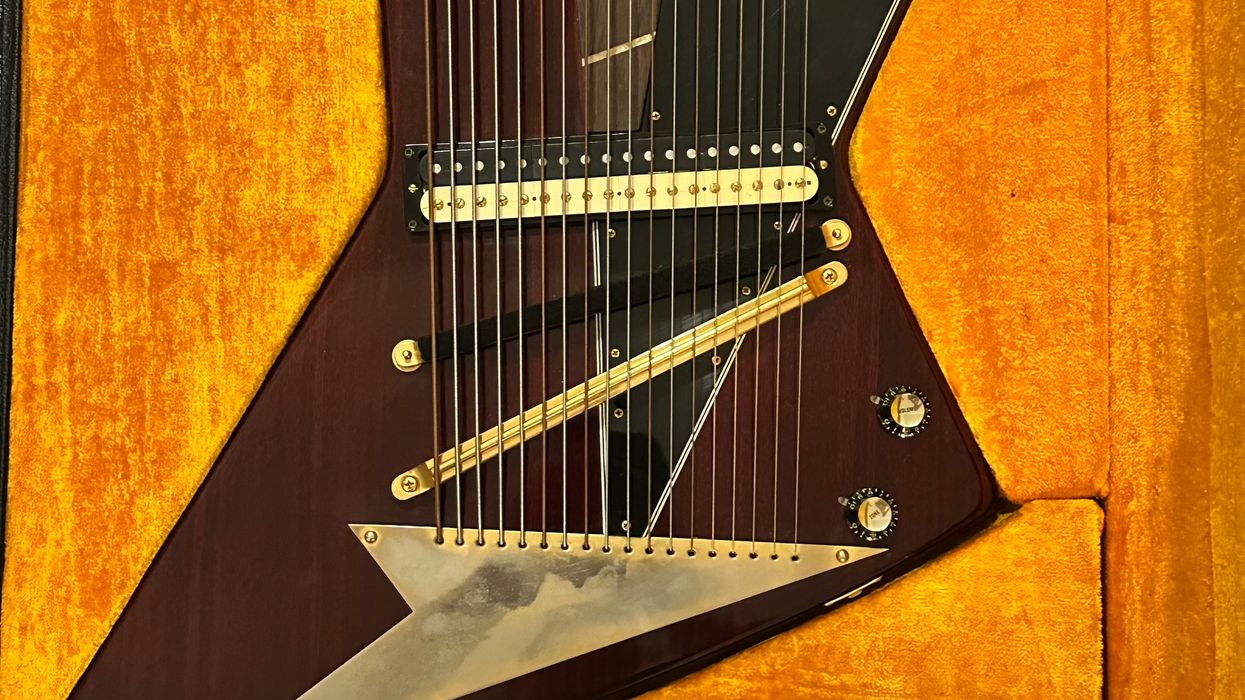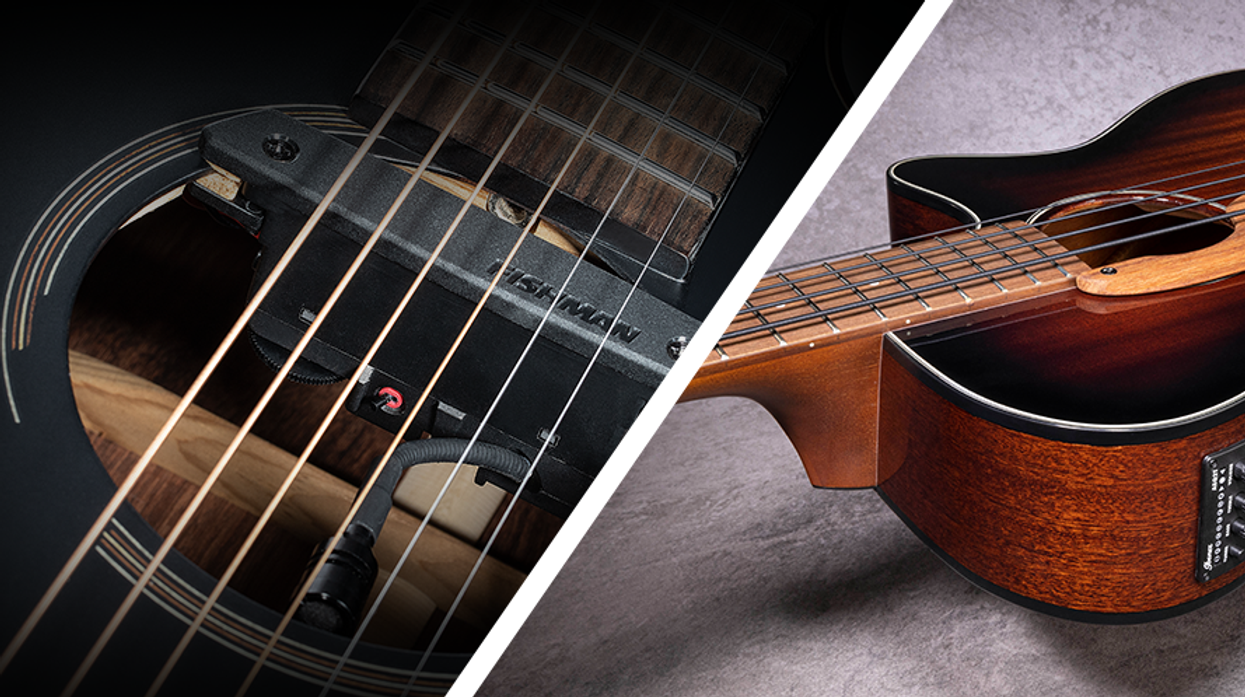Since they first got together 23 years ago in Madison, Wisconsin, Garbage’s Duke Erikson and Steve Marker haven’t been so much a guitar tandem as a guitar collective—a two-man orchestra of intertwining parts and sonic textures. Their approach is less about who does what and more about doing what serves the song.
“We’ve never played a role as far as lead guitar, rhythm guitar, and that stuff,” Erikson says. “We both just do a little bit of everything, and I think we’re more than happy with that. It doesn’t matter really who plays it, as long as it works. We’re pretty easygoing.”
Easygoing about roles, but somewhat perfectionist when it comes to results—it’s an ethic shared by their bandmates, singer/keyboardist Shirley Manson and drummer/producer Butch Vig, and it’s made Garbage one of the enduring successes to emerge from the post-grunge alternative-rock scene. The band’s collaborative nature is reflected in the songwriting credits: No matter where a song starts, the end result is about all four of them.
Coming four years after Not Your Kind of People, the band’s critically acclaimed return from a long hiatus, Strange Little Birds is only the quartet’s sixth studio album—a relatively small output considering that Garbage’s self-titled debut was released in 1995. And while you could put the short discography down to the extended break that began in 2005 and the busy individual schedules of its members, the band’s working method also plays a role. “I wish I could say we do a record in three weeks like a normal band,” Marker says. “But that’s just not us.”
Overflowing with both musical and sonic hooks, Strange Little Birds captures the power of early alternative rock and puts it in a rich, big-screen soundscape that echoes and updates influences ranging from ’60s garage rock to progressive pop to punk to new wave artists like the Cure, Siouxsie and the Banshees, U2, PiL, and David Bowie.
One of Garbage’s goals for Strange Little Birds was to give the album a unified mood. The band sums it up in one word: darkness. But with so many complex textures at play, the darkness is more like shadows, where light sometimes adds form and definition. The songs are dense and accessible, visceral, and thought provoking. Guitar textures range from pure power riffing to synth-like dreamscapes that serve as a reminder that the instrument’s tonal potential didn’t stop evolving in the 1980s. And in a world driven by singles and electronic instruments, it’s also a reminder of the days when albums weren’t merely designed to be heard from beginning to end—an era when it took repeated listening to unveil all of a great record’s musical secrets.
When we caught up with Marker and Erikson, they were preparing for a summer tour. For both, getting ready for the stage meant peeling back the layers of each song, reacquainting themselves with their parts, adapting them for live performance, and finding the essence of their sounds.
When did you start working on the album?
Steve Marker: Probably about two-and-a-half years ago.
Duke Erikson: It feels like a century.
Marker: The hardest is when you haven’t done anything for a while and try to start up again—that was tough for us on the previous record. But on this one we had a lot of momentum, and I was real excited about working again. And knowing us, if nobody pushed to get back in the studio, it could easily turn into another long hiatus, and I didn’t want that to happen. I just started sending stuff, and a couple of things clicked with Shirley pretty quickly.
We tend to be really slow and take our time doing stuff in the studio. We finished the tour for our last album about three years ago. I always find that the end of a tour is when you have the most ideas—the most excitement about the next thing. You’ve spent months playing the songs from the previous album, and you’ve kind of figured out everything you wish you’d done on that, and where you can see it going from there.
Erikson: We occasionally finish a song really quickly, but for the most part we put them away for a long time and come back to them. “Night Drive Loneliness” disappeared for quite a while. We weren’t even going to use it on the record, and then we went back and listened to some of the earlier recordings and found we liked it. I think that’s one of the reasons the record has a kind of cohesiveness—because we were coming back and reworking the songs and trying to keep an overview of what we were up to.
At this point, were you working together or remotely?
Marker: We do a lot of emailing back and forth of ideas and files and stuff, and then when we’ve got something, we get together in L.A., and sometimes in Butch’s basement and in Shirley’s husband’s [engineer and producer Billy Bush] studio.
Erikson:More often than not, it’s all four of us in the studio, listening to whoever’s playing and seeing what they come up with. Somebody will say, “That’s it!” or “Play that again!” Everybody’s sharing ideas all the time. Shirl will get involved in the guitar parts and everything else just as much as Steven and I, you know. She’s very involved in production.
Did any songs on the record come from that early work?
Marker: “Magnetized” and “Sometimes” were things I kind of whipped up at home and sent off. A few days later, I got back a series of emails with some vocal ideas over the top of them, and I could see it could work out well. For “Magnetized,” especially, Shirley had this hook that I just loved. It was just like an A–B–B–A pop vocal line over the top of some really simple chords I’d done on guitar. I started coming out to L.A. and we started working—all four of us in the same room, jamming and drinking wine and playing guitars.
Erikson: We also came up with four or five songs just playing together. Shirley always has a little notebook, and she’ll come up with stuff from the notebook and sing and come up with a melody. That’s actually my favorite, to be honest. You’re a band, you’re all playing together and creating together—true collaboration that started from the very beginning.
You two seem pretty democratic. Do you sit together and work out parts?
Marker: Not in the sense of like, “Let’s grab a couple acoustics and a Corona and go down and play some Eagles songs in the basement.” But this album did have a lot of us four sitting in Butch’s basement playing, and somebody would say, “Let’s do a goth song!”—just as a starting point. It may even start off as humorous, like, “Oh right, we’re going to do a goth song!” But then it turns into something else, and if it’s a good day it’ll go somewhere. I played a lot of bass to start off, because I find that’s a really good way to come up with chord progressions and get some melodic harmonies going.
Speaking of bass, how did you handle that on the record?
Marker: We do everything except the bass. A lot of the parts, one of us came up with as we were writing the songs. But then in the interest of having a better track, we had somebody who can actually play the bass come in for the recording. Eric Avery [Jane’s Addiction], who’s played on lots of our records now, was in for several of the tracks, and Justin Meldal-Johnsen [Beck] did the rest of it. Some songs have specific parts, but other times we might say, “We’re not sure what should happen here. Just go for it, let’s see what you come up with.” Those guys are both really good at doing that. They’re also really incredible with tones, and getting the right sounds that fit the songs.
Speaking of tones, they seem to cover the spectrum on the album. A lot of the songs—and sounds—seem very visual.
Erikson: I think our songs sound cinematic. With “Blackout,” we were attempting to write a song for a movie. It was originally called “The End.” It would roll with the credits, right? In the old days, we used to have movies on all the time—anything visual, with the sound off, just to look and play along to. I tend to really hear music in a visual way—colors and shapes and visual structure. Seeing something can excite the creative part of your brain a little bit. That sounds a little bit pretentious. [Laughs.] We were really going for a mood and a feel that we all honed in on and all contributed to.
So was that visual element part of your concept for the guitars?
Erikson: Well, a “concept” is a little hard to pin down—to actually say there was a plan. We tried to make this album sound a bit richer, and give the guitars a bit more body here and there. And you know we’ve always wanted to mess with guitar sounds. We always steer away from them sounding exactly like a guitar all the time, and some of the guitars sound like keyboards.
Marker: When we started the band, we wanted to make guitars sound like they’re not supposed to sound—sort of unrecognizable. And so I don’t think we’re really ever happy just plugging in a guitar, turning on the amp, and saying, “Okay, I’m ready now.” It’s always got to be messed with, and it can take a lot of time. There’s a lot of trying to make it sound like a Kraftwerk synthesizer, or make it sound like Robert Fripp’s work with Eno and Bowie, or make it sound like, you know, the Edge. I think that’s where things get interesting.
Were you conscious of the sounds in your early demos or did that come later?
Marker: That’s a good question. On a demo you have to come up with a sound that’s going to be inspiring in some way. In order to get an idea across, you have to kind of push it farther than maybe it actually would end up on the record. “Magnetized” was super, super saturated, distorted, four chords, just over and over. But if you just plugged in and went direct and had this crappy little tinny sound it wouldn’t really convey the feeling. I had this sort of majestic thing in my head ... so you have to work on it a bit.
But the sounds all get changed. There aren’t too many guitar licks that I did at home that we didn’t redo in the studio. The overall picture changes as everybody starts to work on it. But it’s important to have some sort of atmosphere around what you’re doing all the time.
Pursuing “an element of looking for something distinctive that will set a sound apart” is part of Marker’s philosophy. He chases that onstage with two models of Henman guitars, including this Mod with Seymour Duncan JB pickups. Photo by Lindsey Best
Is it a matter of finding the sound for the song? Or can the sound inspire or influence the composition itself?
Erikson: It’s sort of a process. “Blackout” was just us jamming really, just playing. I think I played a baritone guitar on that, tuned to open D. The main guitar riff and that bass part are what got us going on that song. The sound of that baritone inspired that part. So that indeed does happen a lot: You have a good sound, and you find something within that sound that influences what you’re going to play. And if you pick up a different instrument, put a capo on, etc., you’re thinking outside that box a little bit. We do that a lot as well. We always have a lot of guitars on hand.
Marker: We played a lot of really weird, cheapo old guitars. It adds an element of just looking for something distinctive that will set a sound apart. For instance, Pat [Smear] from the Foo Fighters gave Butch this Hagstrom. It’s kind of a piece of junk. I think it was about 80 bucks or so, but it sounds great! You probably couldn’t take it on the road because it wouldn’t hold up, but in the studio you can duct-tape it together enough that it’s going to work, and you’re going to get weird sounds you can’t get anywhere else. Our engineer Billy Bush got into this thing where he goes on Reverb.com all the time, looking for cheapo, like, Japanese guitars and stuff like that—just a couple hundred bucks maybe, but really interesting. Some of them have all these weird buttons, you don’t even know what they do. We use them for character. You don’t want to end up sounding generic.
Since you both cover so much sonic territory, is it ever hard for one of you find a part to play?
Marker: “Even Though Our Love Is Doomed” started off as an almost all synth-based song. Shirley did this incredible vocal that was really intimate and simple, and she did it in, like, one take, and it was tough for me to figure out, “How am I going to fit into this?” If there wasn’t a role for me, I guess I would sit it out—which would be fine too, if that’s what it takes. It didn’t need a rhythm guitar, it didn’t need a distorted guitar, and so I ended up doing some sort of Edge-like harmonics—echoey, spacey things on the end, just a little harmonic pattern that repeats itself in a circular fashion. That ended up fitting.
Steve Marker’s Gear
Guitars
• Guild Bluesbird
• Henman Rocka and Mod models with Seymour Duncan JBs
Amps
• Line 6 Helix
• Audio Kitchen Little Squirrel
• Mojave Plexi 45
• Audio Kitchen 1x12
• Mojave 2x12 with Celestion G12H and Blue Alnico speakers
Effects
• Audio Kitchen Reverb
• Eventide TimeFactor
• Seymour Duncan SFX-03 Twin Tube Classic Preamp
• Roland RE-20 Space Echo
Strings and Picks
• Ernie Ball Slinkys (.011–.048)
• Dunlop Tortex .88 mm
Duke Erikson’s Gear
Guitars
• 2001 Guild Starfire III with Seymour Duncan Seth Lovers
• 2000 Fender Custom Shop Telecaster
• Line 6 James Tyler Variax
• 2000 Fender American Standard Stratocaster with bridge Seymour Duncan JB
• 1998 Gibson ES-335 with Seymour Duncan Antiquity (neck) and Seth Lover (bridge)
Amps
• Matchless DC-30 head and cab (Mark Sampson era)
• Audio Kitchen Big Chopper and 2x12 cab
• Silvertone Twin 12 and 2x10 cab
• Fender Super Reverb
• Diezel VH4
• Line 6 Helix
• Marshall 1960TV 4x12
Effects
• Mission Engineering Expression Pedal
• Eventide H9
• Eventide SpaceFactor
• Eventide TimeFactor
• Eventide PitchFactor
• Devi Ever Bit Mangler
• Native Instruments Guitar Rig 5 (modeling software)
Strings and Picks
• Ernie Ball Slinky RPS Nickels (.010–.046)
• Fender Mediums
I think it was right around the time Bowie passed away, so I was listening to a lot of that, and there was also a guitar line that could’ve been from [Bowie’s 1978 album] Heroes. That didn’t make the final version. I think it was too much. But it was days and days of messing around with little things like that, trying to atmospherically change—to support where the song was going without messing it up and getting in the way.
“Blackout” has sort of really heavy guitars. That was something Duke came up with when we were first jamming, and I was playing the bass. I wanted to get things sounding a bit like one of my favorite bands, the Cure. Part of their sound is a really chorus-y bass. There are a few kind of cool sounds from the ’80s [chuckles.] I guess I went on a bit of a nostalgia trip on some of this album. A lot of sounds remind me of something like Siouxsie and the Banshees or the Cure, where’s it’s inspired by the ’80s—or even the early ’70s.
Are you conscious of both guitar parts at that point? Or are you each just thinking about your part and leaving room for the other to add his ideas?
Marker: That’s not really how we think about it at all. Some of these songs have eight different guitar parts! It’s never, “Here’s Keith Richards over in this speaker and Ron Wood over on the other side”—or even a Duane and Dickey kind of thing.
Erikson: We both just do a little bit of everything, and I think we’re more than happy with that. That’s how it’s always been. Sometimes Steve will be sitting there playing and I’ll offer ideas and he’ll try to play them and vice versa. Shirl will come up with a lot of ideas. Butch plays some guitar here and there, as well. Billy plays a couple keyboard things.
Duke, earlier you described the record as being more cohesive. How do you mean?
Erikson: I think we all worked toward making the songs more dynamic, more accessible—making the songs mean more. Everything revolves around the vocals, and anything that doesn’t contribute to the song’s meaning falls to the wayside. I think that’s more true on this album.
We do a lot of layering when we record, that you maybe don’t hear on the first run through, but it’s there to shape the feel of the song, to contribute to the color of the lyrics. On this record, I think we paid a lot of attention to the mood of the songs. There’s a kind of mood throughout the album, and I think all the layers contribute to that mood. Whereas on previous records, we had a lot of different kinds of atmosphere.
So you’re combining what I’d call “core parts” with layers of atmospheric parts. How do you keep track of it all? And how hard is it to mix?
Marker: If you look on my hard drive there’s 20 or 30 versions of most songs, all starting from the same place but going different places. Sometimes you have to go back to that session from four months ago, where you had that really cool analog synth part … that kind of thing.
Erikson: It can be tricky to make sure everything’s working together, but layering guitars is like adding brushstrokes—adding this color, then that color, seeing what works and stepping back every now and then and looking at it, and going from there.
Did you use modeling software for some of the more experimental sounds?
Erikson: Everything on the record is the guitars through amps. Billy Bush has piles of pedals...
Marker: A huge mountain of pedals on the floor.
Erikson: We had a whole bank of them all set up, and it was just a matter of combining them.
Marker: I don’t even always know what he’s got going on. Billy would have about 10 pedals set up. He’d be clicking them on and off really quick: “Do you like this? Do you like that?”
Erikson: There was always a lot of trial and error to find the right sound. Finding the right guitar sounds has always been about working in the context of the song. I guess that’s not a big revelation. I suppose everybody thinks that way. But speaking for myself—and probably for Steve—we don’t have a guitar sound. I play a Tele and a Starfire live,and in the studio I play a bunch of things. But we don’t insist on having our “guitar sound.”
Marker: It’s about whatever works. My main recording amp was an Audio Kitchen. I used some Fender stuff for bass. I also used an Eventide H9 delay. It’ll kind of do anything you want, and it’ll sync up with the MIDI tempo information from the Pro Tools session—so there’s a lot of cool stuff you can program in, what rhythms you want. We always use Eventide stuff. Back on our first record, the [rackmounted] H-3000 was really fancy stuff for us. The H9 can be programmed from a cell phone. But I don’t like the phone app, because it looks like the engineer is checking his email. He’s actually working on your sounds. [Laughs.]
You’re about to go on tour. Will it be a challenge to translate the guitar parts live?
Marker: I’m frantically going back to those old Pro Tools files that I talked about, trying to figure out what the hell I did on some of these songs. In the studio, it’s really easy to change something real quick—there are some weird open tunings and that sort of thing. You’re tuning to whatever works and sounds right. But then we’re too lazy to write stuff down, just assuming you’re gonna remember it. And of course you never do.
YouTube It
This live in-studio performance encapsulates Garbage’s ensemble aesthetic, with guitarists Duke Erikson and Steve Marker igniting the tune “Empty,” the first single from Strange Little Birds, via their honed layering that’s chock-full of dynamic and tonal shifts.











![Rig Rundown: Russian Circles’ Mike Sullivan [2025]](https://www.premierguitar.com/media-library/youtube.jpg?id=62303631&width=1245&height=700&quality=70&coordinates=0%2C0%2C0%2C0)













![Rig Rundown: AFI [2025]](https://www.premierguitar.com/media-library/youtube.jpg?id=62064741&width=1245&height=700&quality=70&coordinates=0%2C0%2C0%2C0)




















 Zach loves his Sovtek Mig 60 head, which he plays through a cab he built himself at a pipe-organ shop in Denver. Every glue joint is lined with thin leather for maximum air tightness, and it’s stocked with Celestion G12M Greenback speakers.
Zach loves his Sovtek Mig 60 head, which he plays through a cab he built himself at a pipe-organ shop in Denver. Every glue joint is lined with thin leather for maximum air tightness, and it’s stocked with Celestion G12M Greenback speakers.











